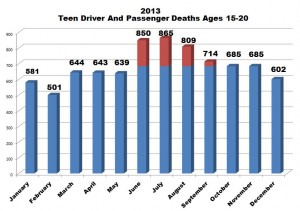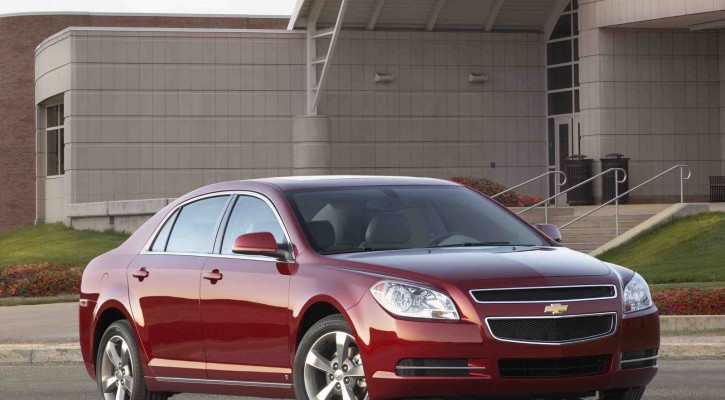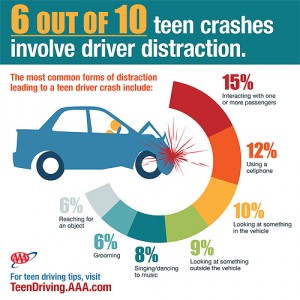Tag Archive: Teen drivers

100 Deadliest Days For Teens
May 7, 2015
May is here and that means proms, graduations and the beginning of the 100 deadliest days for teens. Due to the above average number of teen driving deaths, the summer driving period – between Memorial Day and Labor Day – is historically known as the 100 deadliest days for teens.
In 2013, the last year for which there are figures, there was a monthly average of 685 teen drivers and passengers, aged 15 through 20, who lost their lives on US roadways. During the months of June through September, 498 additional teen drivers and passengers lost their lives in traffic crashes; an increase of 18.25% over the annual monthly average.
 What are the reasons for this increase in teen traffic deaths? Some of the reasons include:
What are the reasons for this increase in teen traffic deaths? Some of the reasons include:
- Lack of experience behind the wheel.
- Bored, unsupervised teens looking for excitement.
- Distracting passengers.
- Long, hot days on the beach or lake that can lead to dehydration and fatigue.
- Use of alcohol and drugs.
What can parents do to reduce this risk?
- Set limits for the number of passengers a teen can carry (this limit may already be set by law in your state).
- Set and enforce curfews.
- Keep your teen busy with chores or a summer job.
- Ban the use of cell phones and texting while driving.
- Avoid the temptation to check up on your teen by calling or texting while the teen may be driving. Instead, set a rule that the teen must call you upon arrival at a destination and upon departure.
- If necessary, use a smartphone app that can limit your teen’s cell phone use while driving along with tracking his or her whereabouts.
- Agree upon and sign a teen driving contract with your teen and enforce penalties for violations.
- If your teen is to be a passenger of another teen driver, know who that driver is and refuse permission if the teen is carrying too many passengers. Every teen passenger a teen driver carries increases the crash risk.
Don’t let your teen become a 100 deadliest days statistic.

Binge Drinking By Teens Affects Their Adult Behavior
April 3, 2015
Binge drinking by teens can lead to genetic changes that will affect their adult behavior according to a study by researchers at the University of Illinois at Chicago College of Medicine and published online in the journal Neurobiology of Disease.
The researchers used rats as a model for teens. They gave adolescent rats, at 28 days of age, alcohol for two days on and two days off for 13 days. Later, as the rats matured, they were able to observe the adult rats for behavior changes and their preference for alcohol. Compared to rats that weren’t given alcohol as adolescents, the “binge drinking” rats showed more anxiety-like behaviors as they entered adulthood and, when given a choice between water or alcohol, showed a preference for the alcohol.
While most of our genetic makeup is present at birth, some genes can be changed through exposure to chemicals in the environment that are absorbed through the lungs or consumed in food or liquids. These chemical and environmental changes to our genetic makeup are known as epigenetics.
In the study, the brains of rats that were given alcohol as adolescents showed changes in the area of the brain known as the amygdala. They found increased levels of a protein (HDAC2) that causes the DNA to be tightly wrapped. The tightly wound DNA, together with the increased level of the protein limits the ability of nerve cells to form new synaptic connections.
The researchers felt that the tightly wound DNA strands prevented the formation of new connections needed in the rapidly developing adolescent brain. That the inhibited growth leads to more anxious behaviors and the tendency toward alcoholism in adults.
The one bit of good news was the discovery that a cancer drug known to block expression of the HDAC2 protein was able to reverse the effects of the tightly wound DNA strands in adult rats. However, it will take years of research to find out if the drug will also work on adult humans and whether or not the drug will have to be given long-term to reverse the effects of the alcohol consumed during adolescence.
The best cure is prevention.
Read more: Adolescent drinking affects adult behavior through long-lasting changes in genes
Driver Distractions Contribute To 60 Percent Of Teen Crashes
March 26, 2015
Driver distractions are a factor in almost 60 percent of teen crashes according to a new report by the AAA Foundation for Traffic Safety. To gather the data for this study, researchers viewed dash cam footage from teen drivers age 16 to 19 who participated in the study. From this data, the researchers were able to view the actions of the teen drivers in the final seconds leading up to a total of 1,691 teen crashes that occurred between August 2007 and July 2013.
The data showed that driver distractions were a factor in 58 percent of the teen crashes. The AAA infographic below shows the most common types of distracting behavior leading to a crash. (Click on graphic to enlarge)
Cell phones and other teens aren’t the only types of driver distractions. A recent study from Oregon State University found that twenty-seven percent of teens admitted to changing clothes and shoes while driving. They also reported changing contact lenses, putting on makeup, and doing homework behind the wheel.
As expected, use of cell phones was a major factor in the AAA study and the researchers feel that the involvement of cell phones occurs more often than government statistics show. In the crashes where cell phone use was a factor:
- Drivers operating or looking at cell phones looked away from the forward roadway excessively – spent an average of 4.1 seconds out of final 6 seconds before the crash looking away.
- The driver exhibited no reaction at all before impact in over half of rear-end crashes involving cell phone use.
In a previous article, we reported that speed and driver distractions were the most common cause of teen crashes. According to the AAA study, excessive speed was a factor in 79 percent of the single vehicle crashes. When excessive speed and driver distraction are combined, the results can be deadly.
Read more: Fact Sheet – Environmental Factors and Driver Behaviors in Teen Driver Crashes

Iowa Parents Need Teen Driver Education
March 17, 2015
Iowa parents are putting their teen drivers in danger – in writing. According to a study by the Iowa Department of Transportation, a majority of Iowa parents signed waivers that exempted their teen drivers from passenger restrictions under Iowa’s Graduated Driver License (GDL) law.
In 2013, the Iowa legislature passed a law that restricted the number of passengers a teen driver can carry to one unrelated passenger for the first six months after receiving their intermediate license. This is a common GDL law that has been passed in many states. In some states, teen drivers can’t carry any passengers other than a sibling for the first six months.
GDL laws were passed in an effort to allow more time for a teen to gain more driving experience without distractions. The reason for the passenger restrictions is that, the more teen passengers a teen driver carries, the more distracting the driving situation is. According to the Governors Highway Safety Association, adding just one passenger increases a teen driver’s crash risk by 50 percent. Put three or more passengers in the car, and that “risk is nearly four times greater.
The Insurance Institute for Highway Safety says that Iowa could cut its fatal teen crash rate by more than half if tougher teen driving laws were enacted.
For some reason, when the Iowa legislature passed this law, they included a provision that allowed parents to sign a waiver that exempted their teen from the passenger restriction provision. This appears to be a popular provision because 90 percent of parents of teen first time drivers have signed the waiver.
If parents were educated on just how dangerous teen passengers of teen drivers can be, they might reconsider and revoke the waiver. Even without such a law, parents should limit the number of passengers their teen driver can carry until the teen driver has six months to a year of driving experience.
Read more: Majority of Iowa parents waive teen driving restriction

Consumer Reports Lists Safest Used Cars For Teens
March 12, 2015
Consumer Reports has come out with a list of what they believe are the safest cars under $10,000 for teens. This list, combined with a similar list by the Insurance Institute for Highway Safety (IIHS) published last summer, can be a valuable guide for parents who are in the market for a used car for their teen driver.
Both the IIHS list and the Consumer Reports list are similar in that they rely on crash data and on safety equipment, either standard or optional, included in each vehicle model. In both lists, the standard safety equipment includes:
- Electronic Stability Control (ESC) – ESC helps the vehicle remain on the road and prevents rollovers in emergency situations. According to Consumer Reports, ESC is, statistically, the biggest safety improvement since seat belts. ESC became mandatory on all vehicles built after 2012 but many manufacturers started offering it as standard equipment in prior model years. According to Consumer Reports, vehicles equipped with ESC “will also have anti-lock brakes and probably traction control, since they require all the same hardware components.”
- Side Impact Air Curtains – Front airbags are mandatory on all vehicles but side impact air curtains are important to protect the vehicle occupants in side crashes.
While not specifically listed as a safety device, those vehicles with adjustable steering wheels and foot pedals allow shorter drivers to adjust the seat a safe distance from the front airbag while still being able to comfortably reach the foot pedals and see over the steering wheel.
Another feature that buyers should look for are adjustable shoulder harnesses. Adjustable shoulder harnesses allow drivers of any height to comfortably place the shoulder harness in the proper position across the shoulder bone and centered over the breastbone. Many drivers, especially shorter ones who find that the shoulder harness rubs against their neck, may try to place the shoulder harness behind them – an extremely dangerous practice.
As in the IIHS list, the Consumer Reports list includes vehicle options that buyers should steer away from if the car is being purchased for a teen driver. Those options include:
- MyFord Touch – ”a distracting infotainment system.”
- Toyota RAV4 – Optional third seat – too many teens in a vehicle are distracting and play a large part in teen crashes.
The Consumer Reports list points out Bluetooth and hands free phone systems included in some models but buyers should be aware that some state laws prohibit the use of any type of wireless communications by teens while driving, whether it’s hands-free or not.
For more information visit: Safest used cars under $10,000 for teen drivers
Photo courtesy of: cargurus.com

